6. The ultimate proof of understanding is to see that
predictions come true. Therefore the modern exact sciences have
been so successful - not until after many repeated trials from other
viewpoints (other persons) - which appear always to confirm the same
results - will something be incorporated into the current
storage for knowledge. But the living presence never stays
still forever and
therefore the
methods of our modern world hard sciences will never work.
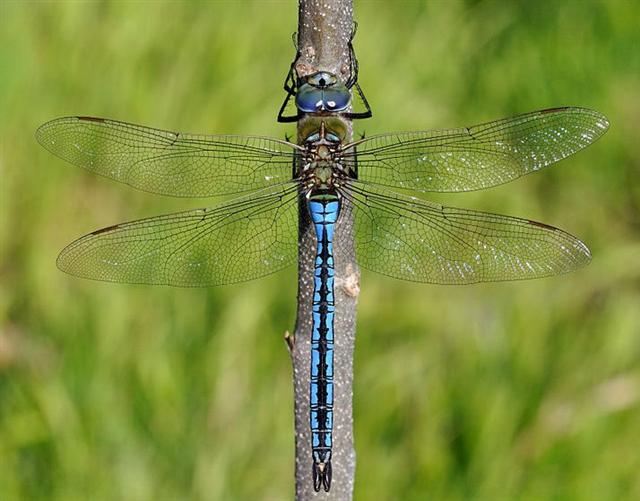
Here and now the challenge is to look ahead in the E text from
the beginning of its side a to the Sign at the end of line a3,
remarkably similar to that at the end of line b3 on the B tablet:
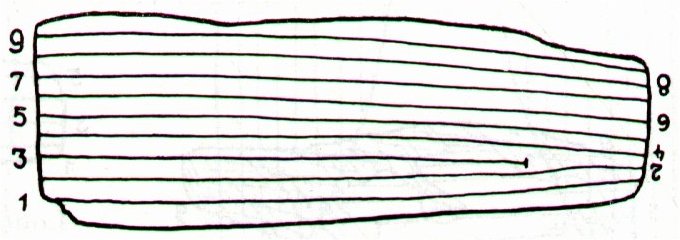
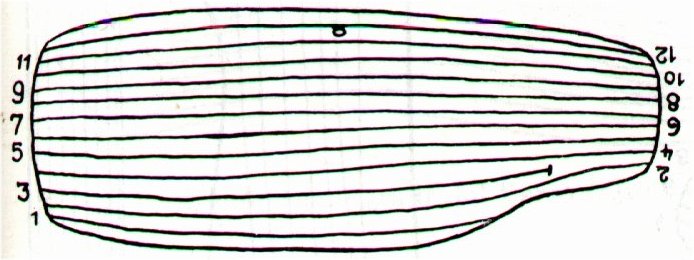
Comparison with the B text has revealed its truncated line
number b3 presumably meant someone was 'defeated' in November 27
(331 → 121 + 210
↔ 141 + 190):
 |
 |
 |
|
Bb3-41 (540 = 3 * 180) |
Bb3-42 (541 -
421 = 120) |
Bb3-43 (542 =
177 + 365) |
|
Itzam-Yeh
defeated |
28 May (148 = 225 -
77), 3149 BC |
|
1st 3-stone place |
21 May (141 = 225 -
84), 3114 BC |
|
Creation of our
present world |
13 August (225), 3114
BC |
|
Och ta chan
(Hun-Nal-Ye 'entered or became the
sky') |
5 February (36 = 141
- 105), 3112 BC |
|
21 May, 3114 BC - 5 February, 3112
BC = 224 + 282 + 36 =
506
+ 36 = 542
542
'happens to be' the sum of 365 days
and 6 * 29½ nights. |
|
|
mai tae vere
hia - ki te pito o
te henua |
e nuku hoi |
kua here te toa - i ruga o to
maro |
|
Vere. 1. Beard, moustache (vede
G); vere gutu, moustache; verevere,
shaggy, hairy, tow, oakum. Mgv.: veri,
bristly, shaggy, chafed (of a cord long in use).
Mq.: veevee, tentacles. Ta.: verevere,
eyelash. 2. To weed (ka-veri-mai, pick,
cut-grass T); verevere, to weed. P Mgv.:
vere, to weed. Mq.: veéveé,
vavee, id. 3. Verega, fruitful,
valuable; verega kore, unfruitful,
valueless, contemptible, vain, futile,
frivolous; tae verega, insignificant,
valueless; mataku verega kore, scruple.
Mgv.: verega, a design put into
execution; one who is apte, useful, having a
knowledge how to do things. 4. Ta.: verevere,
pudenda muliebria. Ma.: werewere, id.
(labia minora). Churchill. Sa.:
apungaleveleve, apongaleveleve, a
spider, a web. To.: kaleveleve, a large
spider. Fu.: kaleveleve, a spider, a web.
Niuē:
kaleveleve, a
cobweb. Nukuoro: halaneveneve,
a spider. Uvea: kaleveleve,
a spider. Mgv.: pungaverevere,
a spider. Pau.: pungaverevere,
cloth. Mg.: pungaverevere,
a cobweb. Ta.: puaverevere,
id. Mao.: pungawerewere,
puawerewere,
puwerewere,
a spider. Ha.: punawelewele,
a spider, a web. Mq.: pukaveevee,
punaveevee,
id. Vi.: lawa,
a fishing net; viritālawalawa,
a cobweb; butalawalawa,
a spider. Churchill 2.
Pito. 1. Umbilical cord; navel;
centre of something: te pito o te henua,
centre of the world. Ana poreko te poki, ina
ekó rivariva mo uru ki roto ki te hare o here'u
i te poki; e-nanagi te pito o te poki, ai
ka-rivariva mo uru ki roto ki te hare, when
a child is born one must not enter the house
immediately, for fear of injuring the child
(that is, by breaking the taboo on a house where
birth takes place); only after the umbilical
cord has been severed can one enter the house.
2. Also something used for doing one's buttons
up (buttonhole?). Vanaga. Navel. Churchill. H
Piko 1. Navel, navel string, umbilical cord.
Fig. blood relative, genitals. Cfr piko pau
'iole, wai'olu. Mō ka piko, moku
ka piko, wehe i ka piko, the navel cord is
cut [friendship between related persons is
broken; a relative is cast out of a family].
Pehea kō piko? How is your navel [a
facetious greeting avoided by some because of
the double meaning]? 2. Summit or top of a hill
or mountain; crest; crown of the head; crown of
the hat made on a frame (pāpale pahu);
tip of the ear; end of a rope; border of a land;
center, as of a fishpond wall or kōnane
board; place where a stem is attached to the
leaf, as of taro. 3. Short for alopiko.
I ka piko nō 'oe, lihaliha (song), at the
belly portion itself, so very choice and fat. 4.
A common taro with many varieties, all with the
leaf blade indented at the base up to the
piko, junction of blade and stem. 5. Design
in plaiting the hat called pāpale 'ie. 6.
Bottom round of a carrying net, kōkō. 7.
Small wauke rootlets from an old plant.
8. Thatch above a door. 'Oki i ka piko,
to cut this thatch; fig. to dedicate a house.
Wehewehe. |
|
Nov 25 → 9 * 25 = 225 |
26 (330 = 320
+ 10) |
27 (→ 225 + 2
→ π) |
|
Al Kalb-16 (The Heart)
/
Jyeshtha-18 (Eldest)
/
ANA-MUA-1 (Entrance
pillar)
ANTARES = α Scorpii
(249.1),
MARFIK (Elbow) = λ Ophiuchi,
φ Ophiuchi (249.5), ω Ophiuchi (249.8) |
γ Apodis (250.1), σ Herculis (250.3), θ Tr.
Austr. (250.6),
τ Scorpii
(250.7) |
HAN = ζ Ophiuchi
(251.0) |
|
... In China, with
Capricornus, Pisces, and a part of Sagittarius,
it [Aquarius] constituted the early Serpent, or
Turtle, Tien Yuen; and later was known as
Hiuen Ying, the Dark Warrior and Hero, or
Darkly Flourishing One, the Hiuen Wu, or
Hiuen Heaou, of
the Han dynasty, which
Dupuis gave as Hiven Mao. It was a symbol
of the emperor Tchoun Hin, in whose reign
was a great deluge; but after the Jesuits came
in it became Paou Ping, the Precious
Vase. It contained three of the sieu, and headed
the list of zodiac signs as the Rat,
which in the far East was the ideograph for
'water', and still so remains in the almanacs of
Central Asia, Cochin China, and Japan ...

|
|
RIGHT
ASCENSION DAYS AT THE FULL MOON: |
|
No star listed (66) |
No star listed (67) |
Rohini-4 (The Red One)
/
Pidnu-sha-Shame-4 (Furrow
of Heaven)
/
ANA-MURI-2 (Rear pillar - at the foot of which
was the place for tattooing)
ALDEBARAN = α Tauri
(68.2),
THEEMIN = υ² Eridani
(68.5) |
|
May 26 |
27 (80 + 67 =
147) |
28 (148 = 225
- 77) |
|
'April 29 |
30 (120 = 147
- 27 |
'May 1 (121) |
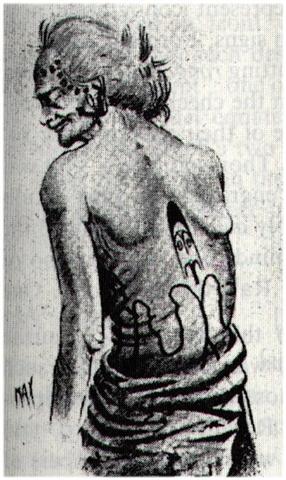 |
And also how in November 28 (→
92 * 8 = 736 → 4 * 184) a new figure entered the stage:
|
 |
|
Bb4-1 (584 - 41 = 3 * 181) |
|
Kua
huki - ko te maro |
|
Nov 28 (332 =
320 + 12) |
|
ζ
Herculis,
η
Tr. Austr.
(252.1), η Herculis, β Apodis (252.5) |
|
May 29 (149 =
332 - 183) |
|
'May 2 (122) |
|
"April
18 (108 = 149 - 41) |
|
No star listed (69) |
|
|
Possibly this person corresponded to the Lono (Rogo) figure because the
Hawaiians said his cycle would (ideally) begin in November 28
(332 → 2 * 166).
... The correspondence between the winter solstice and the
kali'i rite of the Makahiki is arrived at as follows:
ideally, the second ceremony of 'breaking the coconut', when the
priests assemble at the temple to spot the rising of the
Pleiades, coincides with the full moon (Hua
tapu) of the twelfth lunar month (Welehu). In the
latter eighteenth century, the Pleiades appear at sunset on 18
November. Ten days later (28 November), the Lono effigy
sets off on its circuit, which lasts twenty-three days, thus
bringing the god back for the climactic battle with the king on
21 December, the solstice (= Hawaiian 16 Makali'i). The
correspondence is 'ideal' and only rarely achieved, since it
depends on the coincidence of the full moon and the crepuscular
rising of the Pleiades ...
We could try to predict the same pattern by
extrapolating from Ea1-1 (November 14) to the end of line Ea3.
But immediately we will run into trouble, because November 18
appears already at glyph
number 5:
|
Nov 14 (318) |
15 (137 + 182) |
16 (320) |
17 (504 - 183) |
Nov 18
(322) |
|
VISIBLE CLOSE TO THE FULL MOON: |
|
Hairy Head-18 (Cockerel)
/
Temennu-3 (Foundation Stone)
ALCYONE
(56.1),
PLEIONE (28 Tauri), ATLAS (27 Tauri)
(56.3) |
MENKHIB (Next to the Pleiades =
ζ
Persei
(57.6)
PORRIMA (γ Virginis) |
ZAURAK (Boat) = γ Eridani
(58.9) |
λ Tauri (59.3), ν Tauri (59.9) |
4h (60.9)
JĪSHUĬ = λ
Persei
(60.7)
COR
CAROLI (α Canum Ven.) |
 |
|
May 16 (501) |
17 |
18 (74
+ 64) |
19 (139) |
20 (20 weeks) |
|
'April 19 |
20 |
21 (111) |
22 (139 - 27) |
23 |
|
"April 5 |
6 |
7 (88 = 74 + 14) |
8 |
9 (99 = 140 - 41) |
|
MARCH 13 |
14 → 3-14 |
15 (74) |
16 |
17 |
 |
 |
 |
 |
 |
|
Ea1-1 |
Ea1-2 |
Ea1-3 |
Ea1-4 |
Ea1-5 |
|
E hakamata hia
tu mai tae vahu ku huku hia te
vaha ko te tagata - kua mau ki te
hukiga |
|
Va.
1. Hakava, judge, judgement. T Mgv.: akava,
to judge, to pass sentence. Pau.: haava, to judge, to
conjecture. Ma.: whakawa, to charge with crime, to
condemn. Ta.: haava, to judge. 2. Hakava, to
speak. P Mgv.: va, to speak. Mq.: vaa, to
chatter like a magpie. The Marquesan retains more of the
primal sense although the simile is an alien importation. In
Samoa va means a noise, in Tonga va is a
laughing noise, in Futuna va is the disorderly cry of
tumult, and probably it is the initial element of Viti
wa-borabora to speak quickly and confusedly as when
scolding. Its only identification in Tongafiti territory is
Hawaii wawa the confused noise of a tumult ...
Churchill. Ta.: va, space between the leaves in a
roof. Sa.: va, space between. Ma.: wa,
interval. Churchill.
Hu. 1. Breaking of wind. T Mgv.,
uu, to break wind. Mq., Ta.: hu, id. 2. Whistling
of the wind, to blow, tempest, high wind. P Pau.: huga,
a hurricane. Churchill. Mgv.: hu, to burst, to
crackle, to snap. Ha.: hu, a noise. Churchill.
Ha. 1. Four. 2. To breathe.
Hakaha'a, to
flay, to skin. Vanaga. 1. Four. P Mgv., Mq., Ta.: ha, id.
2. To yawn, to gape. 3. To heat. 4. Hakaha, to skin,
to flay; unahi hakaha, to scale fish. Mgv.: akaha,
to take to pieces, to take off the bark or skin, to strip
the leaves off sugarcane. 5. Mgv: ha, sacred,
prohibited. Mq.: a, a sacred spot. Sa.: sa,
id. Churchill.
Vaha.
Hollow; opening; space between the fingers (vaha rima);
door cracks (vaha papare). Vahavaha, to fight,
to wrangle, to argue with abusive words. Vanaga. 1. Space,
before T; vaha takitua, perineum. PS Mgv.: vaha,
a space, an open place. Mq.: vaha, separated, not
joined. Ta.: vaha, an opening. Sa.: vasa,
space, interval. To.: vaha, vahaa, id. Fu.:
vasa, vāsaà, id.
Niuē: vahā. 2.
Muscle, tendon; vahavaha,
id. Vahahora (vaha
1 - hora 2),
spring. Vahatoga
(vaha 1 -
toga 1), autumn. 3. Ta.:
vahavaha, to
disdain, to dislike. Ha.: wahawaha,
to hate, to dislike. Churchill.Vaha.
Hollow; opening; space between the fingers (vaha
rima); door cracks (vaha papare). Vahavaha,
to fight, to wrangle, to argue with abusive words. Vanaga.
1. Space, before T; vaha takitua, perineum. PS Mgv.:
vaha, a space, an open place. Mq.: vaha,
separated, not joined. Ta.: vaha, an opening. Sa.:
vasa, space, interval. To.: vaha, vahaa,
id. Fu.: vasa, vāsaà,
id. Niuē: vahā.
2. Muscle, tendon; vahavaha,
id. Vahahora (vaha
1 - hora 2),
spring. Vahatoga
(vaha 1 -
toga 1), autumn. 3. Ta.:
vahavaha, to
disdain, to dislike. Ha.: wahawaha,
to hate, to dislike. Churchill. |
|
→
INVISIBLY CLOSE TO THE
SUN: |
|
π
Cor. Borealis,
UNUK ELHAIA (Necks of the Serpents) =
λ
Serpentis
(238.1),
CHOW =
β
Serpentis
(238.6) |
κ
Serpentis (239.3),
δ
Cor. Borealis,
TIĀNRŪ =
μ
Serpentis
(239.5),
χ
Lupi, (239.6),
ω
Serpentis (239.7),
BA (= Pa) =
ε
Serpentis,
χ
Herculis (239.8).
κ
Cor.
Borealis, ρ Serpentis (239.9) |
λ
Librae (240.0),
β
Tr. Austr. (240.3),
κ
Tr. Austr. (240.4),
ρ
Scorpii (240.8)
*199.0 =
*240.4 - *41.4 |
Iklīl al Jabhah-15 (Crown of the Forehead)
/
Anuradha-17 (Following
Rādhā)
/
Room-4 (Hare)
ξ
Lupi,
λ Cor. Bor.(241.1),
ZHENG =
γ
Serpentis,
θ
Librae (241.2),
VRISCHIKA =
π
Scorpii
(241.3),
ε
Cor.
Borealis (241.5),
DSCHUBBA
(Front of Forehead) = δ Scorpii
(241.7), η Lupi (241.9) |
υ
Herculis (242.3),
ρ
Cor. Borealis (242.4),
ι
Cor. Borealis (242.5),
θ
Draconis (242.6),
ξ
Scorpii (242.7)
SCHEDIR (Breast) α
Cassiopeiae
*201.0 = *242.4 - *41.4 |
The Hawaiians said that the cycle of Lono should (ideally) begin 10 days
after the Pleiades had returned into view. Here, early in the E
text, we have the Pleiades
already in the night sky of November 14. There is a 4-day difference
(→ 364 - 360 = 4 = 354 -
350).
|
Nov 19 |
20 (324) |
|
VISIBLE CLOSE TO THE FULL MOON: |
|
υ Persei (61.2) |
BEID (Egg) =
ο¹
Eridani
(62.2),
μ
Persei (62.8)
VINDEMIATRIX ( ε Virginis) |
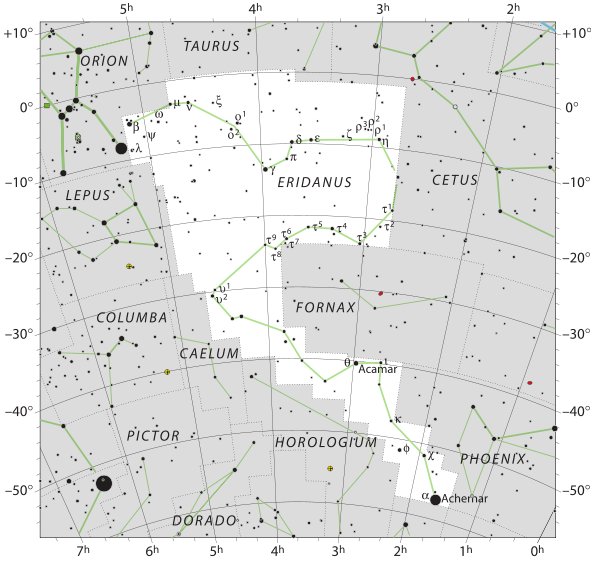 |
|
May 21 (365 + 141 = 506) |
22 (*62) |
|
'April 24 (506 - 27 =
479) |
25 (*35
= 115 - 80) |
|
"April 10 (100) |
11
(*21) |
|
MARCH 18 (442) |
19 (78) |
 |
 |
|
Ea1-6 |
Ea1-7 |
| rere
te toki rere ki uta |
rere
ki te vao |
|
Uta.
Higher up (from the coast, or from another place); i
uta era, further up, up there; ki î te îka i uta,
as there are lots of fish on the beach. Vanaga. 1. Inland,
landward; paepae ki uta, to strand, to run aground;
mouku uta, herbage. 2. To carry; uta mai, to
import; hakauta, to give passage. Campbell.
Vao.
Mgv.: vao, uninhabited land. Ta.: ? [obliterated
text] ... of the valleys. Mq.: vao, bottom of a
valley. Sa.: vao, the bush. Ma.: wao, the
forest. Churchill.
Honui. 1. Person worthy of respect, person of
authority. 2. Livelihood, heirloom, capital;
ka moe koe ki toou hônui, you must marry to ensure
your livelihood (said to a little girl); he hônui mo
taaku poki, this is the heirloom for my son. Vanaga.
Great (hoonui); honui, chief T.; tagata
hoonui, personage; hakahonui, to praise, to
commend. Churchill.
|
|
→
INVISIBLY CLOSE TO THE
SUN: |
|
16h (243.5)
ACRAB (Scorpion) = β Scorpii,
JABHAT AL ACRAB (Forehead of the Scorpion) = ω Scorpii
(243.3), θ Lupi,
RUTILICUS = β Herculis
(243.5),
MARFIK (Elbow) = κ Herculis
(243.7), φ Herculis (243.8) |
ψ
Scorpii (244.6),
LESATH (Sting) =
ν
Scorpii
(244.8) |
 |
|
Nov 21 (506 - 181 = 325) |
→
22 (80 + 246 = 326) |
|
VISIBLE CLOSE TO THE FULL MOON: |
|
Al Dabarān-2 (The
Follower)
HYADUM I =
γ
Tauri (63.4)
*22.0 = *63.4 - *41.4 |
HYADUM II = δ¹ Tauri
(64.2) |
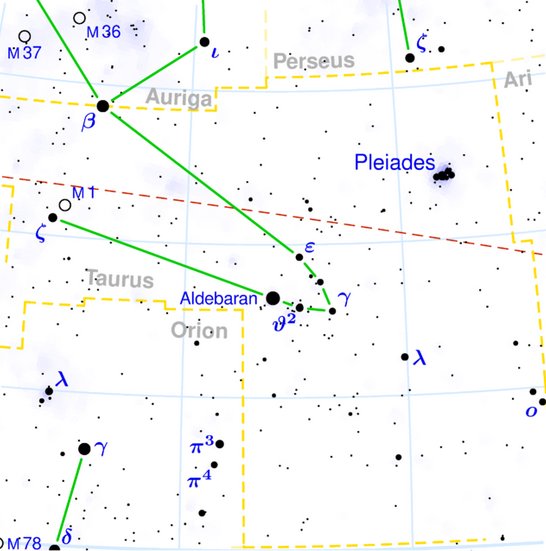 |
|
May 23 (508 = 444 + 64 =
*63) |
24 (*64 = 144 - 80) |
|
'April 26 (481 = 508 -
27) |
27 (*37 = *64 - *27) |
|
"April 12 (*22) |
13 (144 - 41 = 103) |
|
MARCH 20 (*364 = 444 -
80) |
21 (80 = 144 - 64) |
 |
 |
|
Ea1-8 |
Ea1-9 |
| rere
te toki |
rere
ki hau tea - eko te toki |
|
Toki.
Small basalt axe. Vanaga. Stone adze. Van Tilburg.
Ha'amoe ra'a toki = 'Put the adze to sleep' (i.e. hide
it in the temple during the night). Barthel. Month of the
ancient Rapanui calendar. Fedorova according to
Fischer. To'i. T. Stone adze (e to'i purepure
= with the wounderful adze). Henry. The Araukan Indians in
the coastal area of northern Chile, have customs similar to
those on the Marquesas and in both areas toki means
adze according to José Imbelloni. The Araukans also called
their chief of war toki and the ceremonial adze
symbolized his function and was exhibited at the outbreak of
war. In Polynesia Toki was the name of a chief
elevated by the Gods and his sign was the blade of a toki.
Fraser. Axe, stone hatchet, stone tool ...; maea toki,
hard slates, black, red, and gray, used for axes T. P Pau.:
toki, to strike, the edge of tools, an iron hatchet.
Mgv.: toki, an adze. Mq.: toki, axe, hatchet.
Ta.: toi, axe. Churchill. A Maori saying: he iti
toki, e rite ana ki te tangata = though the adze be
small, yet does it equal a man. (Starzecka) |
|
→
INVISIBLY CLOSE TO THE
SUN: |
|
χ
Scorpii (245.1),
YED PRIOR (Hand in Front) =
δ
Ophiuchi,
δ
Tr.
Austr. (245.5) |
YED POSTERIOR (Hand Behind) =
ε
Ophiuchi,
RUKBALGETHI SHEMALI (Northern Knee of the Giant) =
τ
Herculis
(246.6).
δ
Apodis (246.7),
ο
Scorpii (246.8) |
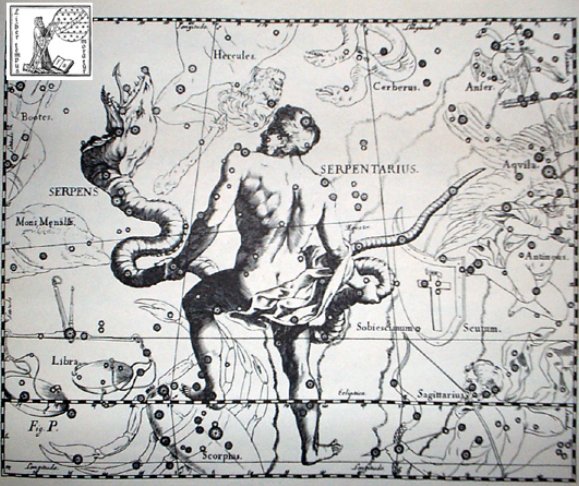 |
The Hand in front and the Hand behind are not referring
to the left respectively to the right hand of the Serpent Carrier,
instead they refer to the front respectively the back side of
his left side hand (rima maori).
The end of line Ea3 comes with
glyph number 32 + 33 + 35 = 100. This place should, according to
my guess, represent day
number 136 (Alcyone) + 100. → 236 (→
8 * 29½) → Gb1-7, where there is an obvious inversion at
heliacal
Altair.
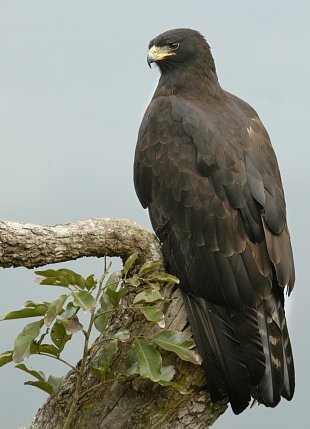
|
NOV 11 (315) |
12 (*236) |
13 |
 |
 |
 |
|
Gb1-6 (235) |
Gb1-7 (8 *
29½) |
Gb1-8 |
|
υ
Aquilae (299.1),
TARAZED = γ
Aquilae
(299.3), δ Sagittae (299.6), π Aquilae (299.9) |
Sravana-23
TYL = ε Draconis
(300.0), ζ Sagittae (300.1),
ALTAIR = α Aquilae
(300.3), ο Aquilae (300.5),
BEZEK = η Aquilae (Ant.)
(300.8) |
ι
Sagittarii (301.2),
TEREBELLUM = ω Sagittarii,
ξ Aquilae (301.3),
ALSHAIN = β
Aquilae
(301.6), φ Aquilae (301.8) |
|
... Another possibility is
that Antinous
represented a voluntary human sacrifice. Our
earliest surviving evidence for this comes from
the writings of Dio Cassius, 80 years after the
event, although it would later be repeated in
many subsequent sources. In the second century
Roman Empire, a belief that the death of one
could rejuvenate the health of another was
widespread, and Hadrian had been ill for many
years; in this scenario, Antinous could have
sacrificed himself in the belief that Hadrian
would have recovered. Alternately, in Egyptian
tradition it was held that sacrifices of boys to
the Nile, particularly at the time of the
October Osiris festival, would ensure that the
River would flood to its full capacity and thus
fertilize the valley; this was made all the more
urgent as the Nile's floods had been
insufficient for full agricultural production in
both 129 and 130. In this situation, Hadrian
might not have revealed the cause of Antinous's
death because he did not wish to appear either
physically or politically weak. Conversely,
opposing this possibility is the fact that
Hadrian disliked human sacrifice and had
strengthened laws against it in the Empire ... |
|
Jan 14 |
15 (*300) |
16 (381) |
|
°Jan 10
(*295) |
11 |
12 (377) |
|
'Dec 18 (*272) |
19 |
20 (354) |
|
"Dec 4 |
5 (339) |
6 (*260) |
|
NAKSHATRA DATES: |
|
MAY 12 (*52) |
13 (133) |
14 (*54) |
|
Mash-mashu-arkū-11
(Eastern One of the Twins)
κ
Gemini (116.1),
POLLUX
= β Gemini
(116.2), π Gemini
(116.9) |
AZMIDISKE
(Little Shield) = ξ Puppis
(117.4)
*116.0 = *117.4 - *41.4 |
φ Gemini
(118.4)
*117.0 = *118.4 - *41.4 |
|
July 15 (196) |
16 (*482) |
17 (*118) |
|
°July 11 (192) |
12 (*478) |
13 (*114) |
|
'June 18 (*454) |
19 (170) |
20 (*91) |
|
"June 4 (*440) |
5 (156) |
6 (*77) |

|























